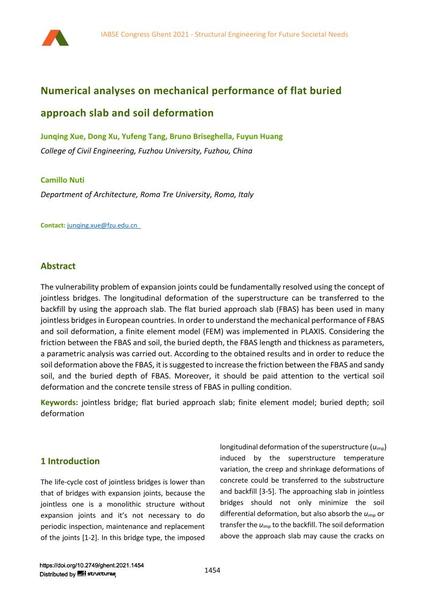Numerical analyses on mechanical performance of flat buried approach slab and soil deformation

|
|
|||||||||||
Bibliographic Details
| Author(s): |
Junqing Xue
(College of Civil Engineering, Fuzhou University, Fuzhou, China)
Dong Xu (College of Civil Engineering, Fuzhou University, Fuzhou, China) Yufeng Tang (College of Civil Engineering, Fuzhou University, Fuzhou, China) Bruno Briseghella Fuyun Huang (College of Civil Engineering, Fuzhou University, Fuzhou, China) Camillo Nuti |
||||
|---|---|---|---|---|---|
| Medium: | conference paper | ||||
| Language(s): | English | ||||
| Conference: | IABSE Congress: Structural Engineering for Future Societal Needs, Ghent, Belgium, 22-24 September 2021 | ||||
| Published in: | IABSE Congress Ghent 2021 | ||||
|
|||||
| Page(s): | 1454-1461 | ||||
| Total no. of pages: | 8 | ||||
| DOI: | 10.2749/ghent.2021.1454 | ||||
| Abstract: |
The vulnerability problem of expansion joints could be fundamentally resolved using the concept of jointless bridges. The longitudinal deformation of the superstructure can be transferred to the backfill by using the approach slab. The flat buried approach slab (FBAS) has been used in many jointless bridges in European countries. In order to understand the mechanical performance of FBAS and soil deformation, a finite element model (FEM) was implemented in PLAXIS. Considering the friction between the FBAS and soil, the buried depth, the FBAS length and thickness as parameters, a parametric analysis was carried out. According to the obtained results and in order to reduce the soil deformation above the FBAS, it is suggested to increase the friction between the FBAS and sandy soil, and the buried depth of FBAS. Moreover, it should be paid attention to the vertical soil deformation and the concrete tensile stress of FBAS in pulling condition. |
||||
| Keywords: |
finite element model jointless bridge flat buried approach slab buried depth soil deformation
|
||||
| Copyright: | © 2021 International Association for Bridge and Structural Engineering (IABSE) | ||||
| License: | This creative work is copyrighted material and may not be used without explicit approval by the author and/or copyright owner. |
||||
